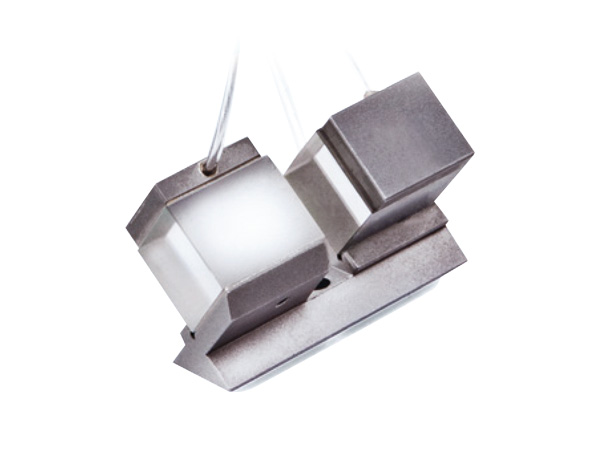
RTP which has only recently become commercially available is the material of choice for many NLO and electro-optic applications. Its high optical damage threshold makes it especially useful in high power SHG and OPO applications. RTPs high electrical
RTP crystal belongs to KTP crystal family. The outstanding electro-optical properties of RTP together with high damage threshold made it possible to use for high-power laser applications in many areas: medical, industrial, defense, etc.
RTP material is widely recognized for these features:
RTP, which has only recently become commercially available, is the material of choice for many NLO and electro-optic applications. Its high optical damage threshold makes it especially useful in high power SHG and OPO applications. RTP’s high electrical resistivity is important for many electro-optic applications, and in the production of Periodically Poled RTP elements.
RTP vs. KTP Comparison Chart
| Property (Type II SHG at 1064nm) | KTP | RTP |
| Phase matchable range (nm) | 980-1080 | 1050-1140 |
| Nonlinear coefficients (pm/V) | ||
| d33 | 16.9 | 17.1 |
| d31 | 2.5 | 3.3 |
| d32 | 4.4 | 4.1 |
| deff | 3.34 | 2.45 |
| Phase matching angle (deg) | 22-25 | 58 |
| Walk-off angle (deg) | 0.26 | 0.4 |
| Angular acceptance (mrad cm) | 20 | 20 |
| Temperature acceptance (°C cm) | 25 | 40 |
| Transparency range (nm) | 350-4500 | 350-4500 |
| Other Properties | ||
| Wavelength of noncritical OPO 1064nm (nm) | 1570/3300 | 1600/3200 |
| Electro optical coefficients (pm/V) | ||
| r33 | 36.3 | 39.6 |
| r13 | 9.5 | 12.5 |
| r23 | 15.7 | 17.1 |
| Dielectric constant εeff | 13 | 13 |
| Optical damage ratio (to KTP) | 1 | 1.8 |
| Electrical conductivity along Z axis (Ω-1 cm-1) | 10-6-10-7 | 10-11-10-12 |
| Pyroelectric coefficient (C/cm2 K) | 7 x 10-9 | 4 x 10-9 |
1. SRC Series Slab RTP EO Cells
Slab EO cell is made of RTP crystals and offers superior properties for users in the aerospace, defense, medical, industrial, civil and scientific applications. Slab RTP EO cells are assembled in a compact and flat thermally compensated double-crystal configuration. It may be used for slab cavity or multi-channels modulations. Due to the unique design, higher average power density can be allowed, as well as elliptical beam or two round beams.
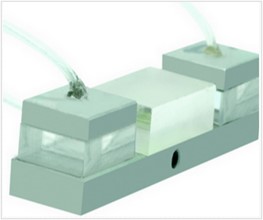
Application:
Advantages:
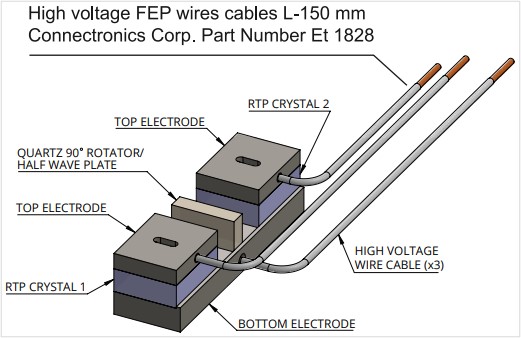
Typical Specifications:
| Operational range | 500-3000nm |
| Transmission @1064nm | >99% |
| Half Wave voltage | 1.5kV (for SLAB EO CELL size: 8x4x10) |
| Extinction ratio | Up to 30dB |
| Clear aperture | 1.5*1.5 mm to 15*15 mm |
| Crystal length | Up to 50 mm |
| Acceptance angle | < 4deg |
| Standard AR coating @1064nm | R < 0.1% |
| Damage threshold | Up to 1 GW/cm2, at 1064 nm, 10 ns pulse |
2. SRC Series RTP EO Devices
RTP (Rubidium Titanyl Phosphate) is a robust electro‐optic crystal suitable for a wide variety of applications (such as Q‐Switches, Amplitude & Phase Modulators, Pulse Pickers, etc.) and operation in industrial, medical, and defense products. The crystal is transparent at most common visible and near infrared laser wavelengths. It performs well over a wide temperature range (from ‐50◦C to +70◦C) and at high repetition rates. RTP based Q‐switch devices are offered in matched pair configurations, in a temperature compensating design. When used for applications such as Q‐Switches and Amplitude Modulators, the crystals are mounted in a way that the input beam is polarized along the diagonal of the face.
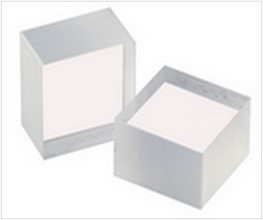
Features:
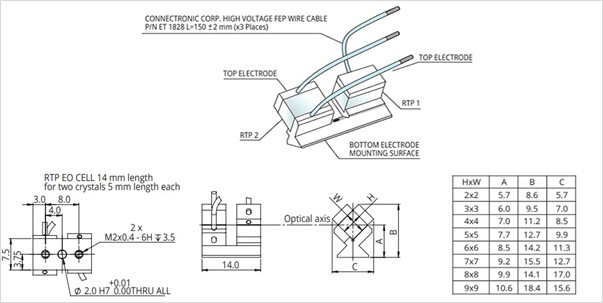
 Single Crystals Tolerances
Single Crystals Tolerances
| Length per crystal (L) | ± 0.5 mm |
| Height (H) / Width (W) | ± 0.10 mm |
| Perpendicularity | < 20 arc min |
| Parallelism | < 10 arc sec |
| Scratch/dig | 10/5 in the clear aperture |
| Chamfers | < 0.2 mm x 45°± 5° |
| Electrodes | Ti on Z-sides |
| Marking | polarity of Z-axis (+) on the side surface |
| AR/AR coatings | : R<0.1% |
| Damage threshold | >600 MW/cm2 @1064 nm, 10ns, 10Hz |
| Side surfaces fine ground | < 30μm |
Matched Pair
Lengths matched to within ± 0.002 mm.
Extinction ratio: transmission ratio of matched pair between parallel/crossed polarizers measured at operating wavelength.
Crystals in V-groove with 90° between Z- axes (+) and (-) on the top. Light polarization vertical or horizontal.
Angular adjustment tolerance: 1.5 degree Transmission: > 98.5%
EO-Cell
Wire type: ET1828, Connectronics Corp. Wires length: 150 mm
Connectronics Corp. Total Capacitance: 2.0-3.0 pF (crystal lengths 5 mm)
and 4.0-6.0 pF (crystal lengths 10 mm)
Static Half Wave Voltage at wavelength (λ, nm) according to the following formulas:
X-cut: Vx = (W/2L) x [(9.35 x λ) - 2000] [V] ± 15%
Y-cut: Vy = (W/2L) x [(8 x λ) - 1900] [V] ± 15%
3. SRC Series RTP FOR ELECTRO-OPTICS (EO)
RTP (Rubidium Titanyl Phosphate) is a robust crystal material suitable for a wide range of electro-optics applications. The Electro-Optics cells (Pockels Cells) are based on two RTP elements in a temperature compensating design that enables the use of these devices within a wide temperature range from -60 °C up to +70 °C.
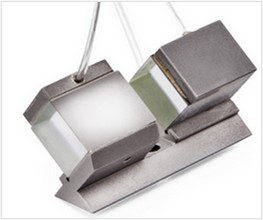
RTP EO Cell Applications:
Advantages:
RTP EO Cell Structure
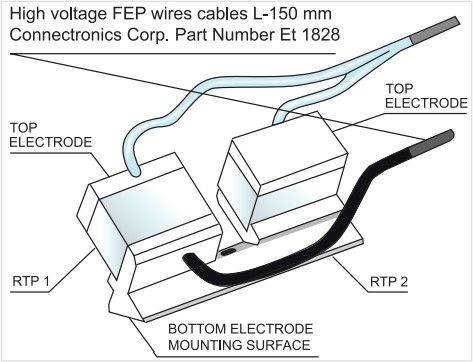
RTP EO Cell Product Offerings
Typical Specifications
| Operational Range | 500-3000 nm |
| Transmission @ 1064 nm | > 99% |
| Half wave voltage | 3.6 kV (for EO Cell size: 9*9*10 mm*2) |
| Extinction ratio | Up to 30 dB |
| Clear aperture | 1.5*1.5 mm to 15*15 mm |
| Crystal length | Up to 50 mm |
| Acceptance angle | < 4 deg. |
| Standard AR coating @ 1064 nm | R < 0.1% |
| Damage threshold | Up to 1 GW/cm2, at 1064 nm, 10 ns pulse |
4. SRC Series IRTP Pockels Cell
RTP (Rubidium Titanyl Phosphate) is a robust electro‐optic crystal suitable for a wide variety of applications (such as Q‐Switches, Amplitude & Phase Modulators, Pulse Pickers, etc.) and operation in industrial, medical, and defence products. The crystal is transparent at most common visible and near infrared laser wavelengths. It performs well over a wide temperature range (from ‐500C to +700C) and at high repetition rates. RTP based Q‐switch devices are offered in matched pair configurations, in a temperature compensating design. When used for applications such as Q-switches and Amplitude Modulators, the crystals are mounted such that the input beam is polarized along the diagonal of the face. Our Q-switch is built using 2 RTP (Rubidium Titanyl Phosphate) elements in a temperature compensating design. The unique properties of RTP, including high electrical resistivity (~1012 Ω-cm) and a high damage threshold, result in a Q-switch with excellent properties.
Our new SRC Series IRTP Pockels Cell is the first product that brings the advantages of RTP to the EO mass market. This IRTP is a modified version of our RTP, designed specifically for industrial laser applications. It is ideal for applications that require advanced characteristics, such as non-hygroscopic, high thermal stability, and high repetition rates. This IRTP is a standard off -the- shelf solution that offers high performance EO cells at the price of standard industry Pockels Cell.
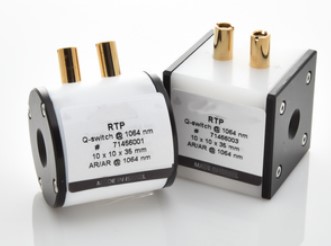
Advantages:
Features:
SRC Series IRTP Pockels Cell Specifications
| IRTP Parameters | SRC-IRTP-6 | SRC-IRTP-8 | SRC-IRTP-10 |
| Aperture | 6x6mm | 8x8mm | 10x10mm |
| Capacitance | <6pf | ||
| Quarter wave voltage (@1064) | 3.3KV | ||
| Optical transmission | >99% | ||
| ER (@1064) | ≥27dB | ||
| Damage threshold | Typically, >1GW/ cm2 | ||
| Alignment access | 1 axis alignment | ||
| Housing Dimensions | Round: θ35mm, length 35mm (there is a 1’’ design) Square: 35mmx35mmx35mm | ||
| Rise time | <1ns | ||
| Thermal Stability | 10-50 Deg | ||
RTP Q-switch working at 30kHz
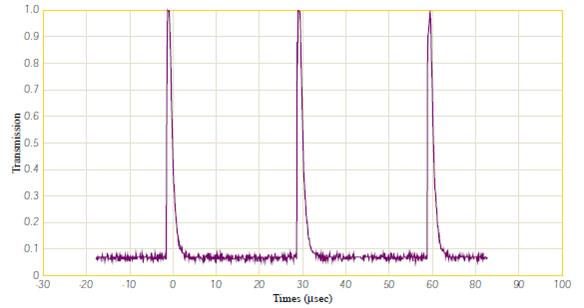
BBO Q-switch working at 30kHz
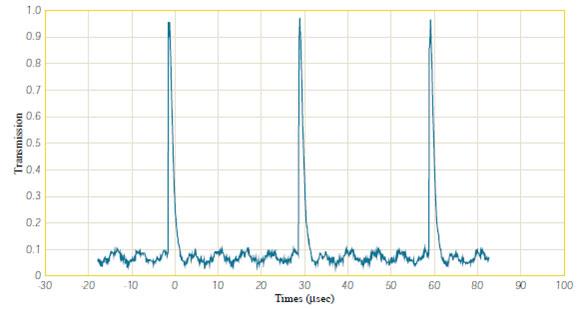
The graphs above show the behaviour of RTP and BBO Q switches at high repetition rates. In particular, the BBO shows Piezoelectric ringing at 30 kHz, while the RTP Q switch shows no ringing at this frequency. The BBO Q switch has a 2.5x2.5x25 mm element, while the RTP Q switch has two 6x6x7mm elements.
A leading supplier and manufacturer of a wide range of photonics products such as lasers,laser parts & machines.
Office: 10 Bukit Batok Crescent #07-02 The Spire Singapore 658079
Tel: +65 63167112
Fax: +65 63167113
Whatsapp: +65 91904616
